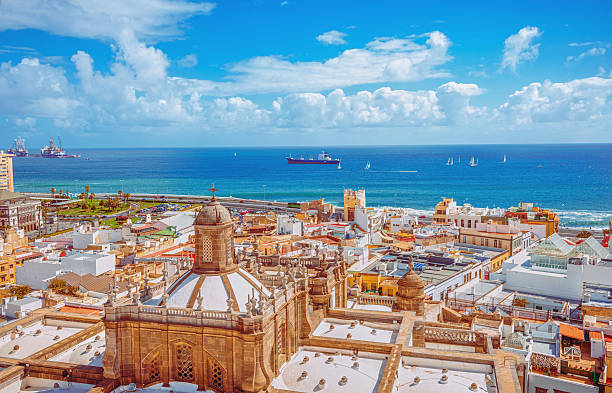
Las Palmas de Gran Canaria, the capital of the island of Gran Canaria, is a city with a rich history spanning over five centuries. Founded on June 24, 1478, by Juan Rejón, captain of the Crown of Castile, the city was named Las Palmas in reference to the many palm trees found on the site at the time of its founding.
The Early Years and the Spanish Conquest
The establishment of Las Palmas was strategic for the Spanish during the conquest of the Canary Islands. The city quickly became an important administrative and commercial center. The conquest was not without resistance, as the Guanches, the indigenous people of the islands, fiercely fought to preserve their territory. Despite this, the Spanish military and technological superiority led to their victory.
Flourishing and Pirate Attacks
In the 16th century, Las Palmas became a key transit point for ships heading to the New World, bringing prosperity and development. However, this wealth also attracted pirates. In 1599, an attack by the Dutch corsair Pieter van der Does almost destroyed the city. The inhabitants valiantly defended their city, inflicting heavy losses on the invaders and preserving their independence.
The Colonial Era and Expansion
The colonial era saw the continued expansion of the city, with the construction of many iconic buildings. The Cathedral of Santa Ana, begun in 1497, is a striking example of Gothic and neoclassical architecture. The Casa de Colón, the former residence of the governor, is famous for hosting Christopher Columbus in 1492 during his voyage to the Americas.
19th and 20th Centuries: Modernization and Development
The 19th century marked the beginning of the modernization of Las Palmas. The improvement of port infrastructure and the opening of the Port of La Luz in 1883 boosted trade and attracted foreign investment. This port became one of the most important in the Atlantic, facilitating trade between Europe, Africa, and the Americas.
During the 20th century, Las Palmas continued to develop. The city experienced rapid population growth and urban expansion. Modern infrastructure, residential neighborhoods, and shopping centers transformed Las Palmas into a dynamic metropolis.
Las Palmas Today
Today, Las Palmas de Gran Canaria is a vibrant and cosmopolitan city, harmoniously blending history and modernity. It is a major cultural and economic center of the Canaries, attracting tourists from around the world with its beaches, pleasant climate, and rich historical heritage. The city is also known for its Carnival of Las Palmas, one of the largest and oldest in Spain.
The history of Las Palmas de Gran Canaria is a testament to resilience and transformation. From its humble beginnings to a leading city in the Atlantic, it continues to fascinate with its heritage and dynamism. Whether through its historical monuments, cultural traditions, or modern development, Las Palmas remains a must-visit destination for history and culture enthusiasts.
Erasmus Life Las Palmas ![]()
